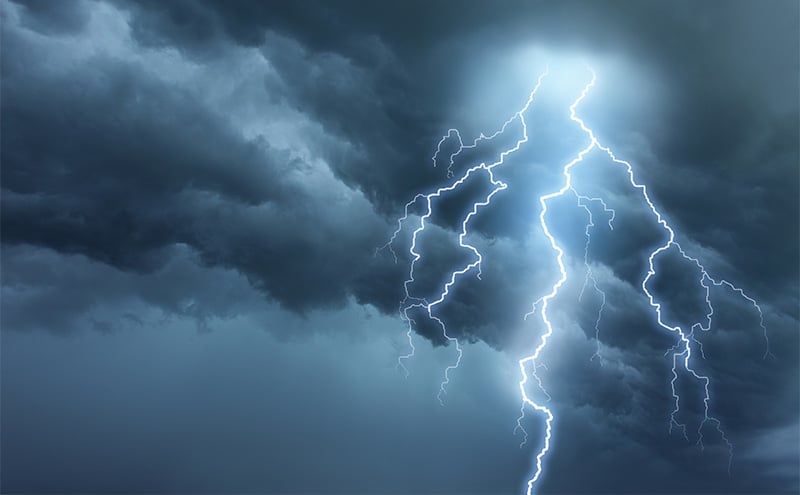
Lightning Injuries: An Electric Case
Case
A 31-year-old male with no significant past medical history presents to the nearest Emergency Department after being reportedly struck by lightning while hiking in Rocky Mountain National Park in the late afternoon. Bystanders state the patient lost consciousness for approximately 1 minute, followed by perceived temporary lower extremity paralysis and right shoulder pain. EMS also states he is bleeding from his right ear, chin, and lip. Patient arrives to the local emergency department hemodynamically stable with a C-collar in place. He denies any facial pain or vision changes but does state he has tinnitus in the right ear. He has tenderness to palpation over the right shoulder but is neurovascularly intact in all extremities. The rest of his exam is unremarkable. An EKG performed shows normal sinus rhythm. The patient is treated with 1L normal saline and given pain medication. The patient’s vital signs remained stable and is transferred to the nearby burn center for partial and deep thickness burns covering approximately 27% of his body.
All emergency physicians need to be prepared to assess and treat lightning injuries, although rare. Lightning strikes are a common environmental cause of death with an annual average of 51 deaths in the United States. Approximately 70-90% of persons struck by lightning survive, but three quarters of these survivors have permanent sequelae (1).
The pathophysiology of lightning strikes involves a short-duration, high-energy electrical discharge that is neither alternating (AC) or direct current (DC) (2). Compared with electrical injuries from alternating current (AC) there is less likely to be deep-tissue destruction. The phenomenon of skin flashover explains why some victims may survive with little to no injury. There are several mechanisms of injury from a lightning strike. These include direct strike, side flash, contact exposure, ground current, upward streamer, and associated blunt or barotrauma. The most common mechanism is side flash, which involves lightning that strikes another nearby object with current flow jumping from initial object to the nearby victim. Direct strike is the deadliest type of strike when the lightning comes into direct contact with the person. Contact exposure involves flow from a contacted object into the victim, whereas ground current occurs when current is transferred to victim(s) through the ground (1).
In the backcountry, you should always focus first on ensuring scene safety for you and any other rescuers. If you can safely move the patient to nearby safe environment, it is reasonable to do so. Assuming the thunderstorm has passed, initiate your assessment with a primary survey (3). Care for multiple victims should focus on the concept of reverse triage. Patients who appear dead should be treated first, given the effects on the cardiovascular system and respiratory center are more likely to be reversible as return of cardiac myocyte activity and respiratory center recovery occur.
Return of cardiac automaticity precedes recovery of the respiratory system as the medullary respiratory center remains paralyzed. A second cardiac arrest may occur if ventilation is not well supported (4).
Keraunoparalysis is neurologic and muscular “stunning” thought to be due to autonomic overstimulation and vasospasm. This can lead to various focal neurologic deficits including lower greater than upper extremity paralysis or sensory loss, or vascular findings secondary to vasoconstriction (4, 5). In the emergency department, focus should be on usual resuscitative care including the principles of ACLS and ATLS, followed by a secondary survey addressing additional injuries.
Some possible effects lightning strike by body system
Cardiac
- Asystole (arrest)
- Myocardial depression
- Coronary artery spasm
- Pericardial effusion
- Arrhythmias
- EKG changes (ie. prolonged QT, T wave inversions, ST elevations or depressions)
Pulmonary
- Respiratory/Hypoxic arrest
Neurologic
- Mechanical brain injury
- Seizures
- Heat-induced cortical coagulation necrosis
- Autonomic dysfunction
- Loss of consciousness, Confusion, Amnesia
Vascular
- Vasospasm (pulse deficits, mottled skin, cool extremities, rarely: compartment syndrome)
Ocular
- Cataracts (most common)
- Hyphema, vitreous hemorrhage, corneal abrasion, uveitis, retinal detachment, retinal hemorrhage, optic nerve damage
Otologic
- Tympanic membrane rupture
- Vertigo, Tinnitus
- Ataxia
- Sensorineural hearing loss
Musculoskeletal
- Blunt force injury, fractures
- Shoulder dislocations
- Rhabdomyolysis (very rare)
Cutaneous
- Lichtenberg figures - pathognomonic
- Superficial feathering pattern resulting from electron showering over skin
- NOT a thermal burn
- Burns (flash, punctuate, thermal, contact - usually with metal)
Strategies for prevention involve close attention to weather, preventing summits during storms, avoiding bodies of water during storms, and seeking shelter in large structures or a car. Dangerous locations to seek shelter include underneath solitary, large trees or in open fields. In the emergency department, assess the patient using ATLS and ACLS guidelines, focus on cardiac monitoring and treatment of identified injuries, and admit patients with uncontrolled pain or persistent neurologic, cardiac, or vascular abnormalities (1,4).
Case Conclusion
The patient has burns to approximately 27% TBSA, mostly partial thickness but with 2% full thickness burns on his back and right upper arm. He does have Lichtenberg figure* over the anterior abdomen and the entry point of the strike is presumed to be the right shoulder with current exiting from the left first toe.
On arrival, patient is hemodynamically stable, and CT scan shows an open right mandibular condyle fracture into the external auditory meatus with no involvement of the tympanic membrane, which is atypical because we would expect a tympanic membrane rupture as noted above.
He is resuscitated with IVF per Parkland formula, his lacerations are repaired, and his initial labs show a peak CPK to 71,300, AST of 1,468, and an ALT of 273. He also has a troponin I of 0.67 which steadily trended downwards. Over several hospital days, CK trended down and his urine output improved 48 hours after arrival to > 1cc/kg/hr. He underwent extensive debridement in the OR with the burn surgery team and graft placement over the right shoulder. Throughout his hospital stay, he went to the OR 3 times and was discharged with close follow up after a 25-day hospital stay.
References:
- Tintinalli, JE, Stapczynski, JS, Ma, OJ, Yealy, DM, Meckler, GD, Cline, D. (2016). Tintinalli's emergency medicine: A comprehensive study guide (Eighth edition). New York: McGraw-Hill Education.
- Blount BW. Lightning injuries. Am Fam Physician. 1990 Aug. 42(2):405-15.
- Zafren K, Durrer B, Herry jp, Brugger H. Lightning Injuries: prevention and on- site treatment in mountains and remote areas. Official guidelines for the International Commission for Mountain Emergency Medicine and the Medical Commission of the International Mountaineering and Climbing Federation. Resuscitation. 65(3):369-72, 2005.
- Davis C, Engeln A, Johnson E, et al. Wilderness medical society practice guidelines for the prevention and treatment of lightning injuries. Wilderness Environ Med. 23:260–269, 2012.
- ten Duis, H.J., Klasen, H.J., and Reenalda, P.E. Keraunoparalysis, a ‘specific’ lightning injury. Burns. 1985; l2: 54–57
Mark Serpico, MD, Emergency Medicine PGY-2
Michael Kidon, DO, Emergency Medicine PGY-2



